Sub-Saharan Africa has a rich history of diverse diets and culinary traditions that have evolved over time. The region’s food culture reflects the influence of various factors, including historical events, cultural practices, and environmental conditions. Understanding the past and present diets of Sub-Saharan Africa is crucial for gaining insights into the region’s food history and the factors that have shaped its culinary traditions.
Key Takeaways:
- Sub-Saharan Africa has a rich and diverse culinary heritage, with diets that have evolved over centuries.
- The history of food in Sub-Saharan Africa is influenced by cultural practices, trade, and agricultural traditions.
- Exploring the past and present diets of Sub-Saharan Africa provides valuable insights into the region’s food culture.
- Traditional foods and cooking methods play a significant role in Sub-Saharan African cuisines.
- Understanding the changes in Sub-Saharan African diets is essential for addressing food security and nutrition challenges in the region.
Historical Diets in Sub-Saharan Africa
The historical diets of Sub-Saharan Africa were shaped by a variety of factors, including cultural practices, agricultural practices, and trade. The region’s rich culinary heritage reflects the diverse indigenous populations and the influence of external cultures throughout history. Traditional Sub-Saharan African diets were primarily based on locally available ingredients such as grains, tubers, fruits, vegetables, and legumes.
“Food is an integral part of our cultural identity and plays a significant role in our daily lives,” says Dr. Amina Jallow, a food historian specializing in Sub-Saharan African cuisine.
“The food traditions in Sub-Saharan Africa have evolved over centuries, adapting to changes in the environment and influenced by the cultural practices of different communities. These diets are not only nourishing but also hold deep cultural and social significance.”
The use of traditional cooking techniques, such as stewing, smoking, and fermenting, added unique flavours and preserved food for longer periods. Indigenous spices, such as peppers, ginger, and cloves, were also widely used to enhance the taste of dishes. Traditional Sub-Saharan African recipes were often passed down through generations, and preserved as cherished family secrets.
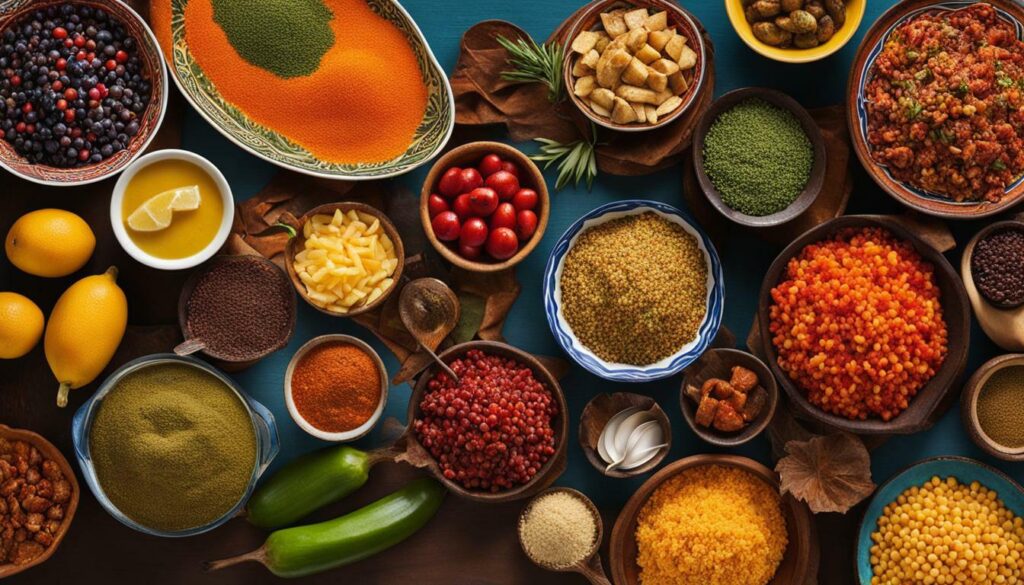
| Traditional Sub-Saharan African Dishes | Main Ingredients |
|---|---|
| Jollof Rice | Tomatoes, rice, onions, and various spices |
| Fufu | Cassava, yam, or plantain |
| Injera | Teff flour |
| Morogo | Wild African spinach |
| Bobotie | Ground meat, eggs, and spices |
Today, traditional Sub-Saharan African cuisines continue to be celebrated and enjoyed both locally and globally. With the merging of old and new influences, modern-day Sub-Saharan African recipes have emerged, combining traditional ingredients and techniques with contemporary twists. The fusion of flavours and culinary creativity has given rise to dishes that showcase the diversity and vibrancy of the region’s food culture.
“The history of food in Sub-Saharan Africa provides a fascinating insight into the region’s rich tapestry of cultures and its journey through time,” concludes Dr. Jallow.
“By exploring the past and present diets, we can gain a deeper appreciation for the culinary traditions that have shaped Sub-Saharan Africa and continue to nourish and excite our taste buds today.”
Evolution of Sub-Saharan African Diets
The diets in Sub-Saharan Africa have undergone significant changes over time due to the influences of colonialism, globalization, and urbanization. These factors have played a crucial role in shaping the food habits and culinary traditions of the region. The introduction of new ingredients and cooking techniques, as well as the adoption of foreign cuisines, have contributed to the evolution of Sub-Saharan African diets.
Colonialism, in particular, had a profound impact on the food culture of Sub-Saharan Africa. The arrival of European colonizers brought about the introduction of new crops, such as maize, potatoes, and cassava, which have become staple foods in many countries. Additionally, the slave trade resulted in the fusion of African and European culinary traditions, giving rise to unique dishes and flavours that are still celebrated today.
Globalization and urbanization have further influenced the diets of Sub-Saharan Africa. The increased accessibility to processed and imported foods has led to changes in eating habits, with a shift towards a more Westernized diet. This shift, coupled with sedentary lifestyles, has contributed to the rise of diet-related diseases, such as obesity and diabetes, in the region.
| Factors | Effects on Sub-Saharan African Diets |
|---|---|
| Colonialism | Introduction of new crops and fusion of African and European culinary traditions |
| Globalization | Increased access to processed and imported foods, leading to a shift towards a more Westernized diet |
| Urbanization | Adoption of fast food and sedentary lifestyles, contributing to the rise of diet-related diseases |
“Food is an integral part of culture, and the changes in Sub-Saharan African diets reflect the broader social, economic, and political transformations in the region. However, it’s important to recognize and celebrate the rich culinary heritage of Sub-Saharan Africa, as traditional foods and cooking techniques continue to hold immense cultural significance.”
Cultural Influences on Sub-Saharan African Diets
The culinary traditions of Sub-Saharan Africa are deeply rooted in its diverse cultures and traditions. Each country and ethnic group within the region has its own unique food culture, influenced by factors such as geography, climate, and religious beliefs. Traditional cooking methods, such as open-fire cooking and fermentation, are still widely practised, preserving the authentic flavours and textures of Sub-Saharan African cuisine.
Indigenous ingredients, such as yams, millet, sorghum, and a wide variety of leafy greens, are key components of Sub-Saharan African diets. These foods are not only rich in nutrients but also reflect the region’s close relationship with the land and its natural resources. The communal aspect of dining is also an important cultural element, with meals often being shared among family and friends as a way to foster social bonds and strengthen community ties.
In conclusion, the evolution of Sub-Saharan African diets has been influenced by historical factors such as colonialism, globalization, and urbanization. The introduction of new ingredients and cooking techniques, as well as the adoption of foreign cuisines, have shaped the food culture of the region. Despite these changes, the traditional culinary traditions and cultural significance of Sub-Saharan African diets remain an integral part of the region’s identity.
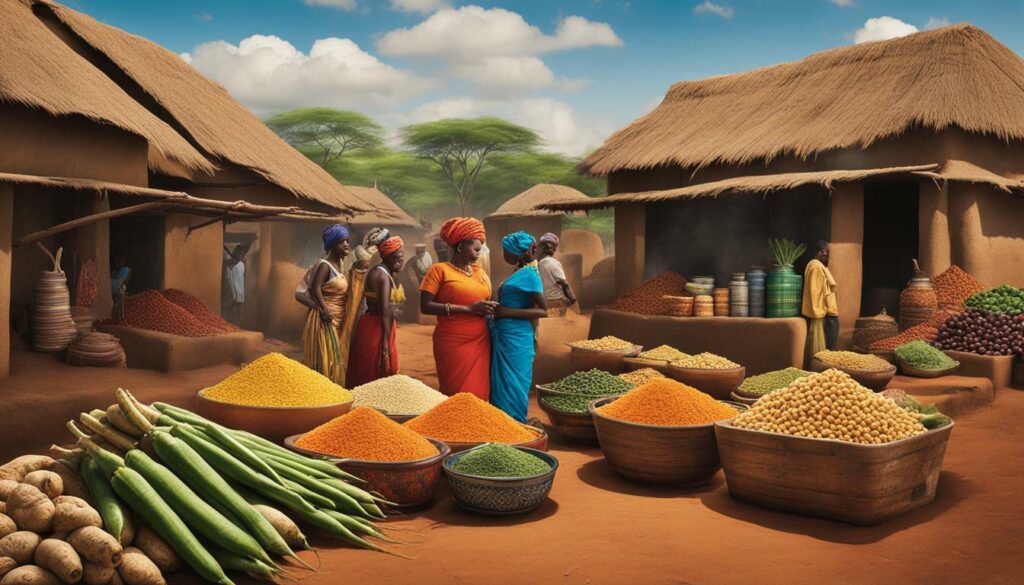
Sub-Saharan Africa is home to a wide range of traditional foods that continue to play a significant role in the local cuisine. These traditional foods are not only rich in flavours but also offer various nutritional benefits. They are deeply rooted in the cultural heritage of the region and reflect the diversity of its people. From staple grains to indigenous fruits and vegetables, Sub-Saharan Africa boasts a plethora of traditional ingredients that have been passed down through generations.
One such traditional food is fufu, a staple dish commonly found in West Africa and Central Africa. Made from pounded starchy ingredients such as yams, plantains, or cassava, fufu is often served with flavorful soups or sauces. Its smooth texture and versatility make it a favourite among locals.

Another popular traditional food is injera, a sourdough flatbread commonly eaten in countries like Ethiopia and Eritrea. Made from fermented teff flour, injera serves as both a staple and a utensil. It is used to scoop up various dishes, such as stews and curries, creating a unique and communal dining experience.
The region also boasts a rich variety of traditional soups, such as the Nigerian egusi soup made from ground melon seeds and the Ghanaian groundnut soup made from peanuts. These savoury dishes are often enjoyed with staple grains like rice, millet, or sorghum.
| Traditional Food | Country/Countries |
|---|---|
| Fufu | West Africa and Central Africa |
| Injera | Ethiopia and Eritrea |
| Egusi Soup | Nigeria |
| Groundnut Soup | Ghana |
These traditional foods not only provide sustenance but also reflect the social and cultural fabric of Sub-Saharan Africa. They are a testament to the region’s rich culinary heritage and the resilience of its people.
Culinary Traditions of Sub-Saharan Africa
The culinary traditions of Sub-Saharan Africa are diverse and reflect the rich cultural heritage of the region. Each country and ethnic group within Sub-Saharan Africa has its own unique flavours, cooking techniques, and ingredients that contribute to the vibrant tapestry of African cuisine. From West Africa’s hearty stews and fufu to East Africa’s aromatic spices and injera, the culinary traditions of Sub-Saharan Africa offer a sensory experience like no other.
One significant aspect of Sub-Saharan African culinary tradition is the emphasis on communal dining. Sharing meals with family and friends is not just about nourishment, but also an expression of social bonds and cultural identity. The act of gathering around a large platter or a communal pot, using one’s hands to eat and engaging in lively conversation, creates a sense of unity and togetherness.
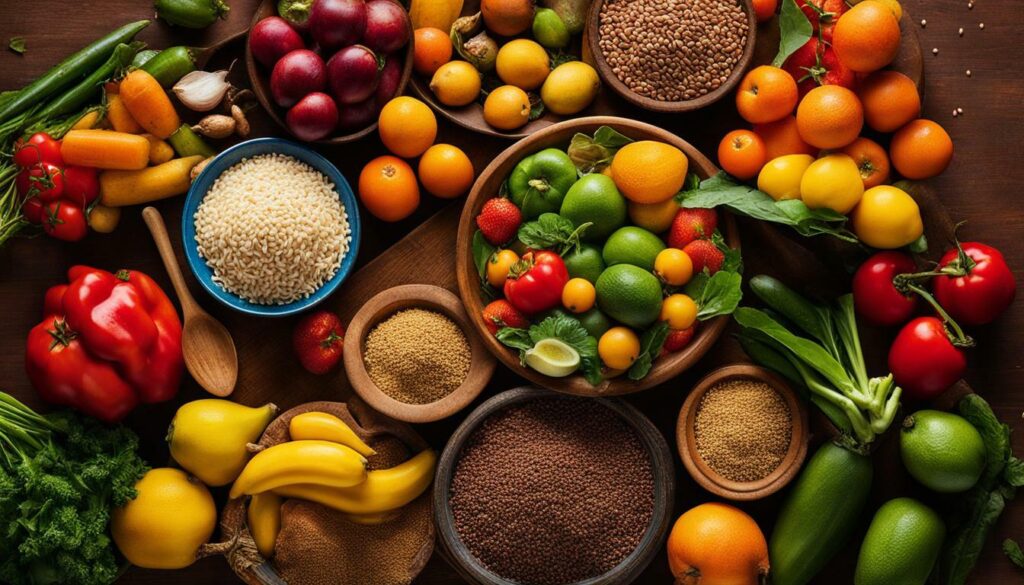
“Food is not only fuel for the body but also fuel for the soul and a celebration of our cultural heritage. Through food, we can connect with our ancestors and preserve our traditions for future generations.” – Chef Kwame, Sub-Saharan African cuisine expert
Traditional Sub-Saharan African Recipes
To truly appreciate the culinary traditions of Sub-Saharan Africa, one must explore the array of traditional recipes that have been passed down through generations. These recipes often reflect the local flavours and ingredients found in each region. Some popular traditional dishes include:
- Jollof Rice – a fragrant rice dish cooked with tomatoes, onions, and a blend of spices, often accompanied by grilled or stewed meat.
- Bobotie – a South African baked dish made with spiced minced meat, topped with an egg-based custard and served with yellow rice.
- Chapati – a thin, unleavened bread commonly enjoyed in East Africa, served with stews or curries.
- Maafe – a rich peanut stew originating from West Africa, typically made with meat, vegetables, and a flavorful peanut sauce.
These traditional recipes showcase the diversity of Sub-Saharan African cuisine and provide a glimpse into the culinary heritage of the region. They are a testament to the creativity and resourcefulness of African cooks, who have transformed simple ingredients into delicious and nourishing meals.
| Country | Traditional Dish |
|---|---|
| Nigeria | Jollof Rice |
| South Africa | Bobotie |
| Kenya | Chapati |
| Senegal | Maafe |
As Sub-Saharan Africa continues to evolve, its culinary traditions remain a vital part of its cultural identity. Preserving and celebrating these traditions not only honours the past but also allows future generations to connect with their heritage through the universal language of food.
Sub-Saharan Africa Nutrition
Nutrition plays a vital role in the lives of people in Sub-Saharan Africa, where staple foods and traditional dietary practices are central to the region’s food culture. The consumption of a diverse range of fruits, vegetables, grains, legumes, and animal products is characteristic of the traditional Sub-Saharan African diet, providing a rich source of essential nutrients.
Traditional Sub-Saharan African dietary practices emphasize the use of locally available ingredients and traditional cooking methods. This approach ensures that meals are not only flavorful but also nutritionally balanced. Traditional dishes often incorporate a variety of spices and herbs, which not only enhance the taste but also offer health benefits.
One example of a staple food in Sub-Saharan Africa is maize, which serves as a source of energy and provides essential vitamins and minerals. It is often consumed in the form of porridge, bread, or as an ingredient in various dishes. Other staple foods include cassava, millet, yams, and sorghum. These foods form the foundation of many meals and provide a steady supply of carbohydrates, proteins, and fibres.
| Traditional Sub-Saharan African Foods | Benefits |
|---|---|
| Fruits and vegetables | Rich in vitamins, minerals, and antioxidants |
| Beans and legumes | Excellent sources of plant-based proteins and dietary fibers |
| Peanuts | Good source of healthy fats and protein |
| Fish and lean meats | Provide high-quality protein and essential fatty acids |
| Palm oil | Contains vitamin E, antioxidants, and beneficial fatty acids |
“The traditional Sub-Saharan African diet is a reflection of the region’s diverse cultures and environments. It not only provides nourishment but also fosters a strong sense of community and identity,” says Dr. Adebisi Johnson, a nutrition expert specializing in Sub-Saharan African food culture.
However, it is important to note that the nutrition transition in Sub-Saharan Africa has led to changes in dietary patterns, with an increasing consumption of processed foods, sugary drinks, and unhealthy fats. This shift, coupled with a sedentary lifestyle, has contributed to the rise in non-communicable diseases such as obesity, diabetes, and cardiovascular diseases in some countries.
Despite these challenges, efforts are being made to promote healthy eating habits and improve food security in the region. Government initiatives, community-based programs, and collaborations with international organizations aim to raise awareness about the importance of nutrition and support sustainable agricultural practices. By preserving and embracing traditional food culture, Sub-Saharan Africa can continue to nourish its population and promote overall well-being.
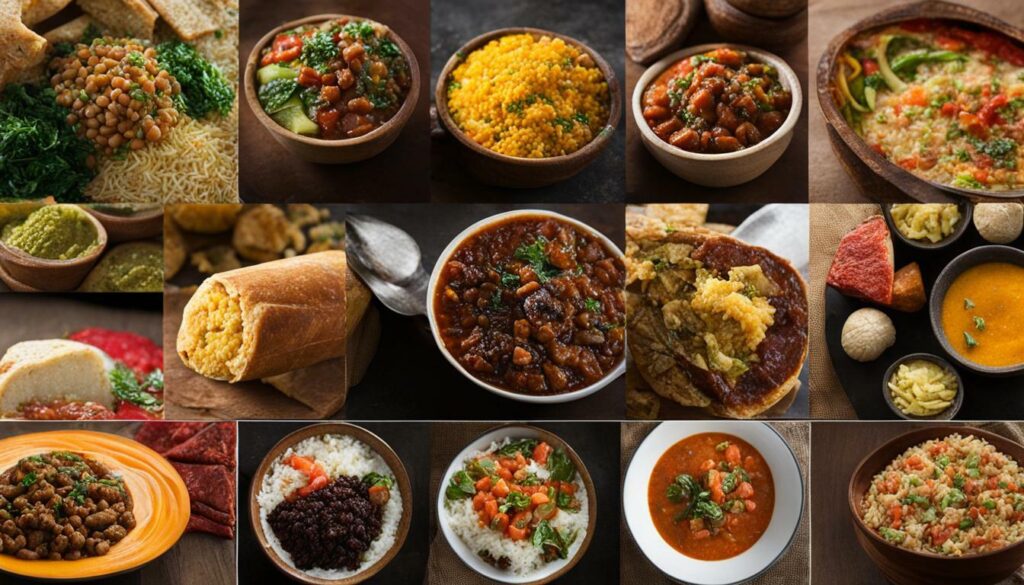
Modern-day cuisines in Sub-Saharan Africa have seen a blending of traditional flavours with contemporary influences, resulting in a vibrant and diverse culinary landscape. The region’s rich cultural heritage and bountiful natural resources have allowed for the creation of unique and tantalizing dishes that showcase the diversity of African flavours. From the fiery stews of West Africa to the delicate grains of East Africa, each country boasts its own distinct culinary traditions.
One of the most popular dishes in Sub-Saharan Africa is the jollof rice, a flavorful one-pot dish made with rice, vegetables, and spices. This iconic dish is a staple in many West African countries and is often enjoyed during festive occasions. Another beloved dish is the injera, a spongy flatbread that is traditionally eaten with various stews and sauces in Ethiopia and Eritrea. The injera is made from teff, a gluten-free grain, and is known for its tangy taste and unique texture.
Sub-Saharan Africa is also known for its wide variety of street foods, which are popular among locals and tourists alike. These street foods range from savoury snacks like samosas and kebabs to sweet treats like fried plantains and coconut candies. They offer a delightful way to experience the flavours and vibrancy of the region’s culinary traditions.
Popular Sub-Saharan African Dishes
Here are some popular Sub-Saharan African dishes that highlight the region’s culinary diversity:
| Dish | Country | Description |
|---|---|---|
| Fufu | Ghana, Nigeria | A staple food made from boiled and pounded cassava or yam, typically served with soups or stews. |
| Bobotie | South Africa | A savory dish made with spiced minced meat, topped with an egg-based custard and baked until golden brown. |
| Bunny Chow | South Africa | A hollowed-out loaf of bread filled with curry, typically made with chicken or mutton. |
| Sukuma Wiki | Kenya | A popular Kenyan dish made with collard greens sautéed with onions, tomatoes, and spices. |
These are just a few examples of the diverse and delicious dishes that can be found in Sub-Saharan Africa. Whether you’re indulging in the bold flavours of West Africa, savouring the delicate spices of East Africa, or exploring the fusion cuisines of Southern Africa, you’re sure to be captivated by the gastronomic wonders of this vibrant region.
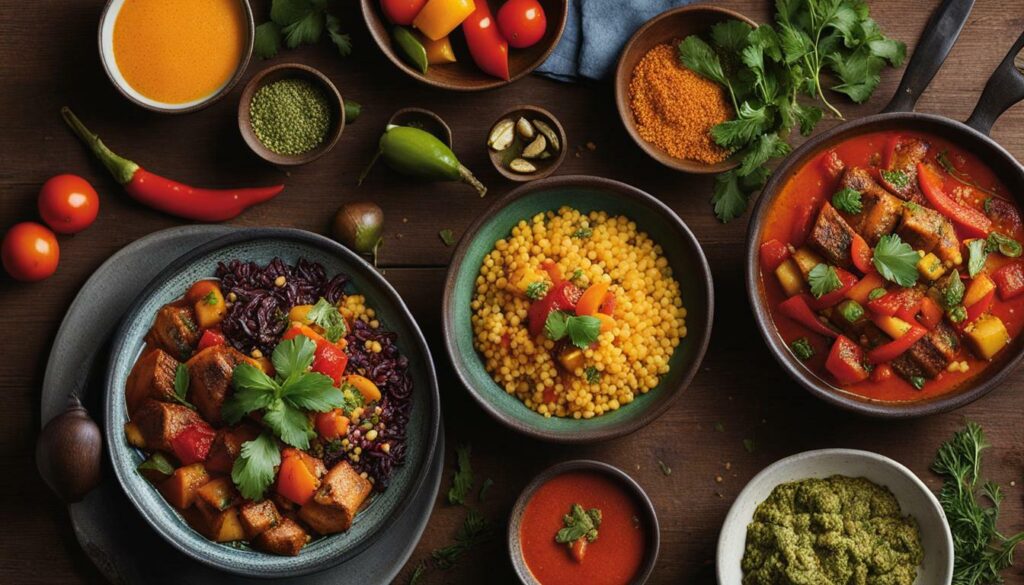
Food Security in Sub-Saharan Africa
Food security is a pressing concern in Sub-Saharan Africa, where many countries are grappling with challenges related to agriculture, nutrition, and the effects of climate change. This study examines the nutrition transition and food security in the region, shedding light on the changes in diet and physical activity patterns and their impact on health outcomes.
A significant finding of the study is that numerous countries in Sub-Saharan Africa are still in the early stages of the nutrition transition. This is characterized by a high prevalence of infant mortality, underweight, and stunting in children, as well as low intake of energy, protein, and fat. However, some countries, such as South Africa, Ghana, and Senegal, have reached a more advanced stage with high levels of obesity/overweight and non-communicable diseases.
The study emphasizes the importance of primordial prevention in countries in the early stage of the transition. Furthermore, it highlights the double burden of underweight and obesity in Sub-Saharan Africa. The coexistence of infectious diseases and non-communicable diseases in the region further adds to the complexity of addressing food security and nutrition issues.
Insights from other sources underscore the relationship between agriculture and nutrition in Sub-Saharan Africa and the role of smallholder farmers in improving food and nutrition security. Additionally, the challenges and opportunities posed by climate change on food production in the region are examined. Understanding these factors is crucial for developing sustainable strategies to ensure food security and promote healthy diets in Sub-Saharan Africa.
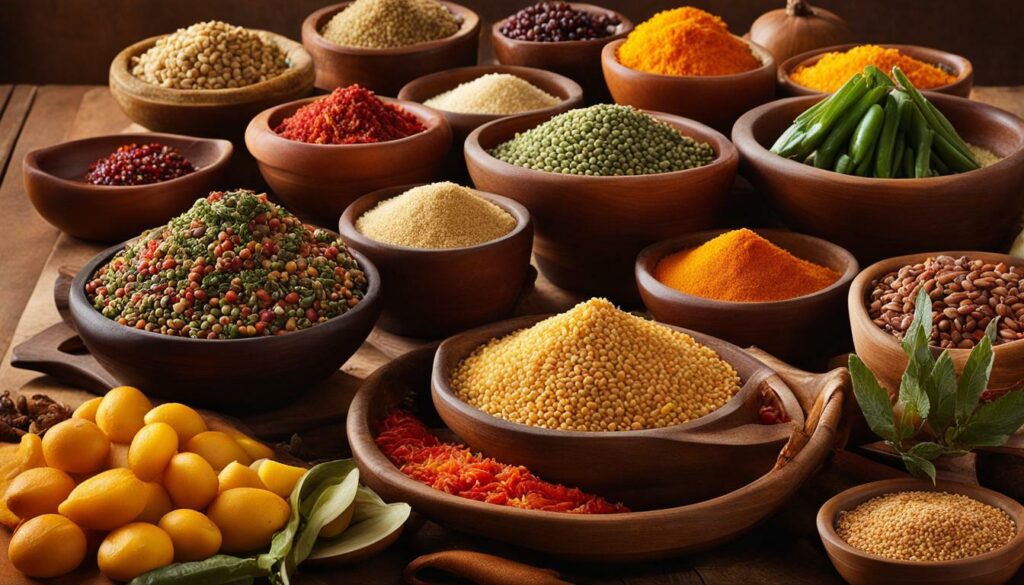
| Key Points: | Food Security in Sub-Saharan Africa |
|---|---|
| 1. | Primordial prevention is crucial in countries in the early stages of the transition. |
| 2. | Some countries, such as South Africa, Ghana, and Senegal, have reached a more advanced stage with high levels of obesity/overweight and non-communicable diseases. |
| 3. | Primordial prevention is crucial in countries in the early stage of the transition. |
| 4. | The double burden of underweight and obesity exists in Sub-Saharan Africa alongside the coexistence of infectious diseases and non-communicable diseases. |
| 5. | The relationship between agriculture and nutrition, the role of smallholder farmers, and the impact of climate change on food production are key considerations for ensuring food security in the region. |
Conclusion
In conclusion, the exploration of past and present diets in Sub-Saharan Africa reveals a fascinating tapestry of culinary traditions, cultural influences, and nutritional practices that have shaped the region’s food culture. Throughout history, Sub-Saharan African cuisines have been influenced by a rich combination of factors, including cultural practices, agricultural practices, trade, and colonialism. These influences have led to the development of diverse and flavorful dishes that reflect the unique identities of different countries and communities within the region.
Traditional foods hold a special place in Sub-Saharan African diets, providing not only sustenance but also cultural significance. From staple foods like maize, millet, and cassava to unique ingredients like palm oil, okra, and baobab fruit, traditional foods continue to be cherished and celebrated. Culinary traditions in Sub-Saharan Africa are characterized by communal dining, where food is not only nourishment but also a means of bringing communities together. The use of spices, herbs, and cooking techniques adds depth and complexity to the flavours, creating a truly sensory experience.
While traditional cuisines remain an integral part of Sub-Saharan African culture, the region has also experienced changes in its diets due to globalization, urbanization, and the fusion of traditional and contemporary influences. Modern-day Sub-Saharan African cuisines have gained recognition on the international stage, with dishes like jollof rice, injera, and bunny chow becoming popular worldwide.
However, as the region continues to progress, it faces challenges in ensuring food security for all its inhabitants. Climate change poses a significant threat to food production in Sub-Saharan Africa, impacting agricultural practices and exacerbating existing challenges. Efforts are being made to promote sustainable and healthy diets, support smallholder farmers, and address the double burden of underweight and obesity in the region.
Overall, the exploration of Sub-Saharan Africa’s past and present diets not only provides insights into the region’s diverse and vibrant food culture but also highlights the importance of preserving and celebrating these culinary traditions. By understanding and valuing the significance of food in Sub-Saharan Africa, we can contribute to the promotion of sustainable and healthy diets for generations to come.
FAQ
What is the nutrition transition?
The nutrition transition refers to the shift in dietary and physical activity patterns that occurs as countries undergo social and economic development. It involves a transition from traditional diets based on locally produced foods to more Westernized diets that are high in processed foods, sugars, and unhealthy fats.
What is food security?
Food security refers to the state of having reliable access to a sufficient quantity of affordable, nutritious food. It encompasses the availability, access, utilization, and stability of food sources and is crucial for ensuring the well-being and health of individuals and communities.
What are the challenges of food production in Sub-Saharan Africa?
Sub-Saharan Africa faces several challenges in food production, including climate change, limited access to modern agricultural technologies, inadequate infrastructure, and lack of investment in agricultural research and development. These challenges contribute to low agricultural productivity and hinder the region’s ability to achieve food security.
What is the double burden of underweight and obesity in Sub-Saharan Africa?
The double burden of underweight and obesity refers to the coexistence of malnutrition and overnutrition in a population. In Sub-Saharan Africa, some countries experience high rates of underweight and stunting in children, alongside rising levels of overweight and obesity in adults. This dual burden poses significant challenges for public health and requires targeted interventions.
How do smallholder farmers contribute to improving food security?
Smallholder farmers, who typically cultivate small plots of land and engage in subsistence farming, play a crucial role in improving food security in Sub-Saharan Africa. They are responsible for the majority of food production in the region and can enhance food security by adopting sustainable agricultural practices, increasing productivity, and promoting diversified and nutritious crops.
What is the impact of climate change on food production in Sub-Saharan Africa?
Climate change poses significant challenges to food production in Sub-Saharan Africa. Rising temperatures, changing rainfall patterns, and extreme weather events can lead to reduced crop yields, decreased agricultural productivity, and increased vulnerability to pests and diseases. Climate change adaptation and mitigation strategies are essential to safeguard food security in the region.
What are non-communicable diseases?
Non-communicable diseases, also known as chronic diseases, are medical conditions that are not caused by infectious agents and cannot be transmitted from person to person. Examples of non-communicable diseases include cardiovascular diseases, cancer, diabetes, and chronic respiratory diseases. These diseases are increasingly prevalent in Sub-Saharan Africa, alongside infectious diseases.
How can primordial prevention help in the early stages of the nutrition transition?
Primordial prevention refers to actions taken to prevent the emergence of risk factors for non-communicable diseases. In the early stages of the nutrition transition, when traditional diets are still prevalent, primordial prevention strategies can focus on promoting healthy dietary patterns and physical activity, as well as addressing social and economic determinants of health.
What is the role of traditional healers in Sub-Saharan African food culture?
Traditional healers play a significant role in Sub-Saharan African food culture. They possess knowledge about medicinal plants and their healing properties, as well as traditional dietary practices for maintaining health and preventing diseases. Traditional healers are often consulted for advice on nutrition and the use of specific foods for therapeutic purposes.
How do agricultural practices influence Sub-Saharan African diets?
Agricultural practices have a profound influence on Sub-Saharan African diets. The cultivation of specific crops, such as staple grains (e.g., maize, rice, millet) and legumes (e.g., beans, cowpeas), shapes the nutritional composition of diets. Traditional farming techniques, such as intercropping and agroforestry, also contribute to dietary diversity by promoting the cultivation of a variety of crops.
Source Links
- https://bmcpublichealth.biomedcentral.com/articles/10.1186/1471-2458-11-801
- https://www.ncbi.nlm.nih.gov/pmc/articles/PMC8774613/
- https://www.frontiersin.org/articles/10.3389/fsufs.2019.00104
Read Our Articles On The Other Regions of Africa Here:
| Past and Present Diets of North Africa |
| Past and Present Diets of West Africa |
| Past and Present Diets of East Africa |
| Past and Present Diets of Central Africa |
| Past and Present Diets Southern Africa |



